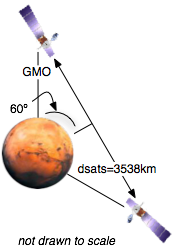 |
||||||||||||
|
||||||||||||
Satellite to Satellite Link |
||||||||||||
|
This link allows the satellites to relay information from one ground terminal to another ground terminal that is communicating with a different satellite. This allows all of the ground terminals to communicate with each other without having to communicate with the earth station first. In this scenario, the satellites act as interstellar "routers" distributing the information to the correct recipient. An efficient higher level protocol will allow fast communication to minimize latency across the network. The since the signals are broadcast using CDMA, by changing the chipping sequence, a ground terminal will be able to decode data from other ground terminals thus allowing ground terminals to communicate with each other. The geometry for this link can be seen in figure 9. Figure 9. Satellite to Satellite link
Since this link is symmetric, link budget calculations are only required for one communication direction. In order to prevent interference with the other links used in this system, the frequency was chosen to be 6Ghz. Performing the same analysis as for the two previous links, a plot of transmit power versus BER can be constructed and the optimum transmit power can be determined (Figure 10). Figure 10: BER vs Transmit Power for Satellite to Satellite Communication
As shown by the chart, only 7W of transmit power is required for this link with a 20dB gain antenna (radius of about 9cm) . The results from this link are shown in table 6. Table 6: Summary of Satellite/Satellite Link
The calculations for these links can be found in the MATLAB file here. The system design (block diagrams and power system) are located in System Design The orbital geometry calculations are located in Spacecraft Orbits |
||||||||||||

